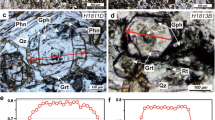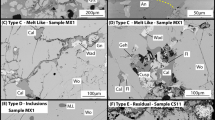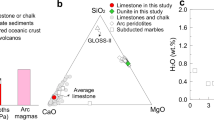Abstract
Carbon is transported from Earth’s surface into its interior at subduction zones. Carbonates in sediments overlying hydrothermally altered rocks (including serpentinites) within the subducted slab are the main carriers of this carbon1. Part of the carbon is recycled back to the surface by volcanism, but some is transferred to the deep Earth1,2. Redox transformations during shallow subduction control the transfer and long-term fate of carbon, but are poorly explored1,3. Here we use carbon stable isotopes and Raman spectroscopy to analyse the reduction of carbonate in an exhumed serpentinite–sediment contact in Alpine Corsica, France. We find that highly crystalline graphite was formed during subduction metamorphism and was concentrated in the sediment, within a reaction zone in direct contact with the serpentinite. The graphite in this reaction zone has a carbon isotopic signature (δ13C) of up to 0.8±0.1‰, similar to that of the original calcite that composed the sediments, and is texturally associated with the calcium-bearing mineral wollastonite that is also formed in the process. We use mass-balance calculations to show that about 9% of the total carbonaceous matter in the sedimentary unit results from complete calcite reduction in the reaction zone. We conclude that graphite formation, under reducing and low-temperature conditions, provides a mechanism to retain carbon in a subducting slab, aiding transport of carbon into the deeper Earth.
This is a preview of subscription content, access via your institution
Access options
Subscribe to this journal
Receive 12 print issues and online access
$259.00 per year
only $21.58 per issue
Buy this article
- Purchase on Springer Link
- Instant access to full article PDF
Prices may be subject to local taxes which are calculated during checkout



Similar content being viewed by others
References
Hayes, J. M. & Waldbauer, J. R. The carbon cycle and associated redox processes through time. Phil. Trans. R. Soc. Lond. B 361, 931–950 (2006).
Frezzotti, M. L., Selverstone, J., Sharp, Z. D. & Compagnoni, R. Carbonate dissolution during subduction revealed by diamond-bearing rocks from the Alps. Nature Geosci. 4, 703–706 (2011).
Connolly, J. Phase diagram methods for graphitic rocks and application to the system C–O–H–FeO–TiO2–SiO2 . Contrib. Mineral. Petrol. 119, 94–116 (1995).
Evans, K. A. The redox budget of subduction zones. Earth Sci. Rev. 113, 11–32 (2013).
Greenwood, H. Wollastonite: Stability in H2O–CO2 mixtures and occurrence in a contact-metamorphic aureole near Salmo, British-Columbia, Canada. Am. Mineral. 52, 1669–1680 (1967).
Caciagli, N. C. & Manning, C. E. The solubility of calcite in water at 6–16 kbar and 500–800°C. Contrib. Mineral. Petrol. 146, 275–285 (2003).
Gorman, P. J., Kerrick, D. M. & Connolly, J. A. D. Modeling open system metamorphic decarbonation of subducting slabs. Geochem. Geophys. Geosyst. 7, Q04007 (2006).
Evans, K. Metamorphic carbon fluxes: How much and how fast? Geology 39, 95–96 (2011).
Ague, J. J. Release of CO2 from carbonate rocks during regional metamorphism of lithologically heterogeneous crust. Geology 28, 1123–1126 (2000).
Evans, K. A., Bickle, M. J., Skelton, A. D. L., Hall, M. & Chapman, H. Reductive deposition of graphite at lithological margins in East Central Vermont: S Sr, C and O isotope study. J. Metamorph. Geol. 20, 781–798 (2002).
Frost, B. R. Mineral equilibria involving mixed-volatiles in a C–O–H fluid phase; the stabilities of graphite and siderite. Am. J. Sci. 279, 1033–1059 (1979).
Chopin, C., Beyssac, O., Bernard, S. & Malavieille, J. Aragonite-grossular intergrowths in eclogite-facies marble, Alpine Corsica. Eur. J. Mineral. 20, 857–865 (2008).
Vitale Brovarone, A. et al. Stacking of continuous segments of subducted lithosphere in high-pressure orogens: architecture of Alpine Corsica (France). Earth Sci. Rev. 116, 35–56 (2013).
Manatschal, G. & Muntener, O. A type sequence across an ancient magma-poor ocean–continent transition: The example of the western Alpine Tethys ophiolites. Tectonophysics 473, 4–19 (2009).
Malvoisin, B., Chopin, C., Brunet, F. & Galvez, M. E. Low-temperature wollastonite formed by carbonate reduction: A marker of serpentinite redox conditions. J. Petrol. 53, 159–176 (2012).
Luque, F. J., Crespo-Feo, E., Barrenechea, J. F. & Ortega, L. Carbon isotopes of graphite: Implications on fluid history. Geosci. Front. 3, 197–207 (2012).
Beyssac, O. et al. On the characterization of disordered and heterogeneous carbonaceous materials by Raman spectroscopy. Spectrochim. Acta A 59, 2267–2276 (2003).
Frost, B. R., Beard, J. S., McCaig, A. & Condliffe, E. The formation of micro-rodingites from IODP hole U1309D: Key to understanding the process of serpentinization. J. Pet. 49, 1579–1588 (2008).
McCollom, T. M. & Seewald, J. S. Abiotic synthesis of organic compounds in deep-sea hydrothermal environments. Chem. Rev. 107, 382–401 (2007).
Beyssac, O., Goffé, B., Chopin, C. & Rouzaud, J-N. Raman spectra of carbonaceous material in metasediments: A new geothermometer. J. Metamorph. Geol. 20, 859–871 (2002).
Beyssac, O., Brunet, F., Petitet, J.-P., Goffé, B. & Rouzaud, J.-N. Experimental study of the microtextural and structural transformations of carbonaceous materials under pressure and temperature. Eur. J. Mineral. 15, 937–951 (2003).
Luque, F. J., Pasteris, J. D., Wopenka, B., Rodas, M. & Barrenechea, J. F. Natural fluid-deposited graphite; mineralogical characteristics and mechanisms of formation. Am. J. Sci. 298, 471–498 (1998).
Miyashiro, A. Oxidation and reduction in the Earth’s crust with special reference to the role of graphite. Geochim. Cosmochim. Acta 28, 717–729 (1964).
Marschall, H. R. & Schumacher, J. C. Arc magmas sourced from melange diapirs in subduction zones. Nature Geosci. 5, 862–867 (2012).
Kerrick, D. M. & Connolly, J. A. D. Metamorphic devolatilization of subducted marine sediments and the transport of volatiles into the Earth’s mantle. Nature 411, 293–296 (2001).
Alt, J. C. & Teagle, D. A. H. The uptake of carbon during alteration of ocean crust. Geochim. Cosmochim. Acta 63, 1527–1535 (1999).
Alt, J. C. et al. Recycling of water, carbon, and sulfur during subduction of serpentinites: A stable isotope study of Cerro del Almirez, Spain. Earth Planet. Sci. Lett. 327-328, 50–60 (2012).
Acknowledgements
This project was financially supported by the ANR JC programme (project GeoCarbons, PI O. Beyssac), CNRS-INSU and the Ville de Paris Emergence programme (project Cycle géologique du carbone organique, PI O. Beyssac). Particularly insightful reviews by D. Rumble and J. Connolly of early versions of the manuscript were much appreciated. This work also benefited from various discussions with C. Chopin, P. Agrinier, J. Dubessy, P. Cartigny, V. Busigny, A. Vitale Brovarone, M. Clog, P. Sans-Jofre, G. Cody and O. Vidal. Finally, we thank J. J. Bourrand and M. Ader for technical assistance.
Author information
Authors and Affiliations
Contributions
M.E.G., O.B., I.M. and K.B designed the research and performed field work, analysed data and wrote the paper; M.E.G performed laboratory work; C.C. developed analytical tools, analysed data and wrote the paper; B.M. and J.M. performed field work, analysed data and wrote the paper.
Corresponding authors
Ethics declarations
Competing interests
The authors declare no competing financial interests.
Supplementary information
Supplementary Information
Supplementary Information (PDF 1903 kb)
Rights and permissions
About this article
Cite this article
Galvez, M., Beyssac, O., Martinez, I. et al. Graphite formation by carbonate reduction during subduction. Nature Geosci 6, 473–477 (2013). https://doi.org/10.1038/ngeo1827
Received:
Accepted:
Published:
Issue Date:
DOI: https://doi.org/10.1038/ngeo1827
This article is cited by
-
Methane-hydrogen-rich fluid migration may trigger seismic failure in subduction zones at forearc depths
Nature Communications (2024)
-
High-temperature electrothermal remediation of multi-pollutants in soil
Nature Communications (2023)
-
Petrological evidence for deep subduction of organic carbon to subarc depths
Communications Earth & Environment (2023)
-
Early release of H2O during subduction of carbonated ultramafic lithologies
Contributions to Mineralogy and Petrology (2023)
-
Petrogenesis of extra-large flake graphite at the Bissett Creek deposit, Canada
Mineralium Deposita (2023)



